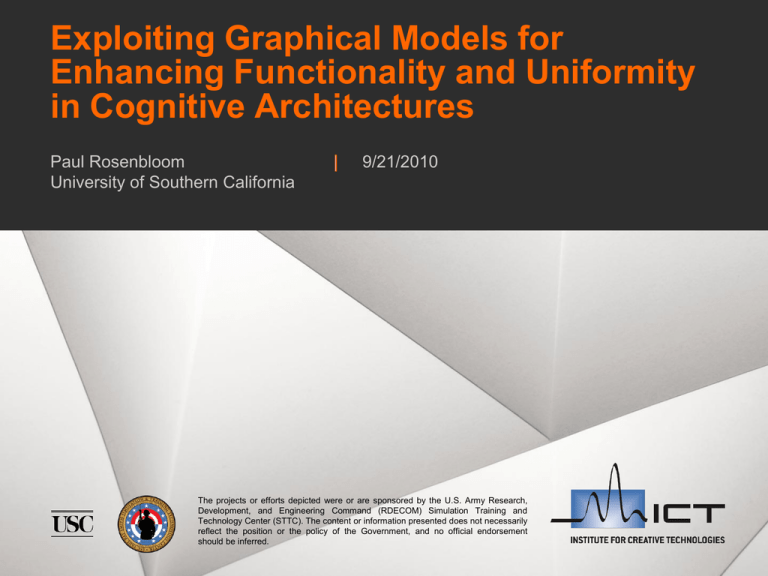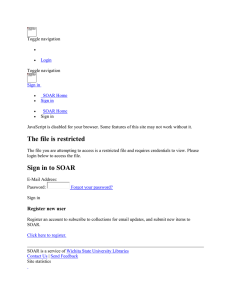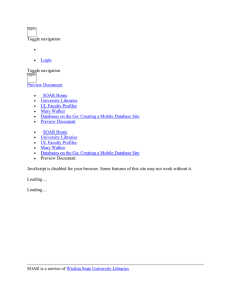Exploiting Graphical Models for Enhancing Functionality and Uniformity in Cognitive Architectures Paul Rosenbloom
advertisement

Exploiting Graphical Models for Enhancing Functionality and Uniformity in Cognitive Architectures Paul Rosenbloom University of Southern California 9/21/2010 The projects or efforts depicted were or are sponsored by the U.S. Army Research, Development, and Engineering Command (RDECOM) Simulation Training and Technology Center (STTC). The content or information presented does not necessarily reflect the position or the policy of the Government, and no official endorsement should be inferred. Outline Cognitive architecture – The Soar architecture – The diversity dilemma – The promise of graphical models Combining broad mixed/hybrid capabilities with uniformity A graphical architecture – An integrative memory architecture Procedural (rule), declarative (semantic, episodic, constraint) – Towards imagery and learning 2 Cognitive Architecture Hypothesis about the fixed structure underlying cognition – Defines core memories, reasoning processes, learning mechanisms, external interfaces, etc. Yields intelligent behavior when combined with knowledge in memories – Including more advanced reasoning, learning, etc. May model human cognition and/or act as core of a virtual human or intelligent agent – Strong overlap with intelligent agent architecture 3 Some Cognitive-Architecture-Based Virtual Humans Improving in mind and body over the years 1997 These all based on Soar architecture 2000 2009 4 Soar Architecture (Versions 3-8) 5 Symbolic working memory Long-term memory of rules Decide what to do next based on preferences generated by rules Reflect when can’t decide Learn results of reflection Interact with world Systems Levels in Cognition In the large, architecture is a theory about one or more systems levels in an intelligent entity – Usually part of Cognitive Band At each level, a combination of structures and processes implements basic elements at the next higher level (Newell, 1990) 6 Hierarchical View of Soar (Versions 3-8) Functionality Mechanism Details 1 sec Reflective Problem Space Search Impasse/Subgoal If Can’t Decide 100 ms Deliberative Decision Cycle Preference-based Decisions upon Quiescence 10 ms Reactive Elaboration Cycle Parallel Rule Match & Firing 7 Learning by Chunking Scale Comments on Soar Pursued for ~30 years as both – A unified theory of (human) cognition – An architecture for virtual humans and intelligent agents Demonstrated a wide range of intelligent behaviors from interactions among a small set of mechanisms – Problem solving and planning methods – Varieties of knowledge and learning – Reflection and interaction Applied to a wide range of tasks – Search-intensive and knowledge-intensive (expert systems) – Cognitive and real-time situated agents/robots I was co-PI 1983-1998 – John Laird (Michigan) has continued as sole PI since then 8 Key Conundrum with Soar (Versions <9) Could demonstrate how the combination of a small set of general mechanisms produced a wide variety of intelligent capabilities and behaviors But were not able to leverage this for integration at the next level, where these intelligent capabilities and behaviors were themselves routinely integrated and used This led to creation of Soar 9 Soar 9 But this in turn raised the diversity dilemma 9 Diversity Dilemma The girth at a level is its range of structures & processes Key issue: uniformity versus diversity Uniformity: Minimal mechanisms combining in general ways – Appeals to simplicity and elegance – The “physicist’s approach” – Challenge: Efficiency and full range of required functionality/coverage Diversity: Large variety of specialized mechanisms – Appeals to functionality and optimization – The “biologist’s approach” – Challenge: Integrability, extensibility and maintainability Want benefits of both! – Can this be achieved by varying girth across levels? Across a hierarchy, level girth may stay comparable or vary – Physicists and biologists likely assume uniform – Network researchers assume hourglass 10 The Internet hourglass Applications Web FTP Mail TCP News Video Audio ping napster Everything Transport protocols on IP SCTP UDP ICMP IP Ethernet 802.11 IP on Power lines ATM Optical everything Satellite Bluetooth Link technologies 7/24/09 Paul S. Rosenbloom From Hari Balakrishnan What About Cognition? Top (applications) is clearly diverse – Key part of what architectures try to explain Bottom is likely diverse as well Applications Architecture Implementation – Physicalism: Grounded in diversity of biology – Strong AI: Also groundable in other technologies Is the waist uniform or diverse? – Hourglass or rectangle – Traditionally question about the architecture 12 Architectural Uniformity vs. Diversity Soar (3-8) is a traditional uniform architecture ACT-R is a traditional diverse architecture Soar 3-8 13 ACT-R Examples Soar (3-8) is a traditional uniform architecture ACT-R is a traditional diverse architecture Recently Soar 9 has become highly diverse Soar 3-8 14 Soar 9 Towards Reconciling Uniformity and Diversity Accept diversity at the architectural level Move search for uniformity down to implementation level Applications Architecture Implementation – Biological Band in humans Locus of neural modeling – Computational Band in AI Normally just Lisp, C, Java, etc. – Impacts efficiency and robustness but usually not part of theory Base on graphical models – Pragmatic and theoretic impact Computational Band Similar to Domingos’s call for an AI interface layer 15 (Newell, 1990) Graphical Models Efficient marginal/MAP computation over multivariate functions by decomposing into products of subfunctions – For constraints, probabilities, speech, etc. – Based on independence assumptions u y x Come in a variety of related flavors – Bayesian networks: Directed, variable nodes w z E.g, p(u,w,x,y,z) = p(u)p(w)p(x|u,w)p(y|x)p(z|x) – Markov networks: Undirected, variable nodes & clique potentials Basis for Markov logic and Alchemy – Factor graphs: Undirected, variable & factor nodes E.g., f(u,w,x,y,z) = f1(u,w,x)f2(x,y,z)f3(z) Compute via variants of – Sum-product (message passing) – Monte Carlo (sampling) 16 w u y x f1 z f2 f3 Properties of Graphical Models Yield broad capability from a uniform base – State of the art performance across symbols, probabilities and signals via uniform representation and reasoning algorithm Representation: My focus has been on factor graphs Reasoning: Sum-product passes messages about elements of variables’ domains Sum-product algorithm yields – – – – (Loopy) belief propagation in Bayesian networks (BNs) Forward-backward algorithm in hidden Markov models (HMMs) Kalman filters, Viterbi algorithm, FFT, turbo decoding Arc-consistency and production match Several neural network models map onto them Support both mixed (symbolic & probabilistic [StarAI]) and hybrid (discrete & continuous) processing – For uncertain reasoning & combining cognitive with perceptuomotor 17 Mixed and Hybrid Processing Symbol processing is norm in cognitive architectures – Generally approached by rules or comparable techniques But much knowledge is uncertain – Architectures may use neural nets or activation-based approaches – Bayesian networks are state of the art Only recently been combined effectively with general symbol processing, to yield mixed processing, and has had little impact so far on cognitive architectures Intelligent systems also need to perceive their worlds – Speech, vision, etc. require extended signal processing – Also significant progress via graphical models Hidden Markov models for speech and Markov random fields for vision – Architectures view this as preprocessing that creates symbols 18 Need hybrid processing to use reasoning in perception and perception in reasoning Message/Variable Range Scope of Sum-Product Algorithm Message/Variable Domain Discrete Continuous Boolean Numeric Symbols Probability (Distribution) Signal & Probability (Density) Mixed models combine Boolean and numeric ranges Hybrid models combine discrete and continuous domains Hybrid mixed models combine all possibilities Dynamic hybrid mixed models add a temporal dimension 19 Research Goals Long term – Radically new architectures combining Enhanced functionality and coverage with Increased simplicity and uniformity Medium term – A uniform implementation of a mixed hybrid variant of existing architectures Short term – A uniform implementation of a mixed hybrid memory architecture 20 Memory Architecture Memories (short- and long-term) used in decisions – Soar 1-8: working memory + production memory – ACT-R: buffers + production memory, semantic memory – Soar 9: working memory, ST visual imagery + production memory, semantic memory, episodic memory, LT visual memory Focus here is on representation and access – – – – Both procedural and declarative knowledge Hybrid: Continuous/signal + discrete/symbolic Mixed: Probabilistic/uncertain + discrete/symbolic Provides syntactic but not necessarily semantic integration across memories – Not yet learning 21 Approach Base roughly on Soar 9 and ACT-R – Working memory – Procedural long-term memory Productions – Declarative long-term memory Semantic: Predict unspecified attributes of objects based on specified ones (cues) Episodic: Retrieve best episode based on recency and match to cues – Eventually imagery as well, but not yet Implement via graphical models – Layered approach: graph and memory layers 22 Graph Layer: Factor Graphs w/ Summary Product Factor graphs are undirected bipartite graphs – Decompose functions: e.g., f(u,w,x,y,z) = f1(u,w,x)f2(x,y,z)f3(z) – Map to variable & factor nodes (with functions in factor nodes) Summary product algorithm does message passing – Output of variable node is pointwise product of inputs – Output of factor node is pointwise product times factor function And then summarize out all variables not on link (by sum or max) Sum: Marginals of variables (distributions over individual variable domains) Max: Maximum a posteriori estimation (best combination across all variables) w u x f1 23 y z f2 f3 Representation of Functions and Messages N dimensional continuous functions – Approximated as piecewise linear functions over rectilinear regions – Potentially could instead use mixtures of exponentials or Gaussians, or wavelets Span (continuous) signals, (continuous and discrete) probability distributions, symbols – Discretize domain for discrete distributions & symbolic [0,1>, [1,2>, [2,3>, … – Booleanize range (and add symbol table) for symbolic 24 E.g., [0,1>=1 RED true; [1,2>=0 GREEN false y\x [0,10> [10,25> [25,50> [0,5> 0 .2y 0 [5,15> .5x 1 .1+.2x+.4y Memory Layer: Distinguish WM and LTM Representation is predicate based – E.g., Object(s,O1), Concept(O1,c) – Arguments may be constants, or variables (in LTM) Long-term memories compile into graph structures – LTM is composed of conditionals (generalized rules) – A conditional is a set of predicate patterns joined with a function WM compiles to evidence at peripheral factor nodes – It is just an N dimensional continuous function where normal symbolic wmes correspond to unit regions with Boolean values Elaboration phase is one settling of graph WM Object: Concept: 25 Constant Pattern Join Function CONDITIONAL ConceptPrior Condition: Object(s,O1) Condact: Concept(O1,c) Conditionals Walker Table Dog Human .1 .3 .5 .1 Patterns can be conditions, actions or condacts – Conditions and actions embody normal rule semantics Conditions: Messages flow from WM Actions: Messages flow towards WM – Condacts embody (bidirectional) constraint/probability semantics Messages flow in both directions: local match + global influence – Encoded as (generalized) linear alpha networks Pattern networks joined via bidirectional beta network Functions are defined over condact variables WM Object: Concept: 26 Constant Pattern Join Function Additional Details Link directionality is set independently for each link – Determines which messages are sent Whether to use sum or max is specified on an individual variable/node basis – Overall algorithm thus mixes sum-product and max-product Variables can be specified as unique or multiple – Unique variables sum to 1 and use sum for marginals: [.1 .5 .4] – Multiple variables can have any or all elements valued at 1 and use max for marginals: [1 1 0 0 1] Predicates can be declared as open world or closed world with respect to matching WM Pattern variables cause sharing of graph structure – May be within a single conditional or across multiple conditionals 27 Memories Production Memory Semantic Memory Just conditions and actions – Although may also have a function CWA and multiple variables CONDITIONAL Transitive Condition: Next(a,b) Just condacts (in pure form) OWA and unique variables Naïve Bayes (prior on concept + conditionals on attributes) CONDITIONAL ConceptWeight Condact: Concept(O1,c)[1] Weight(O1,w) Next(b,c) Pattern Action: Next(a,c) Join WM CONDITIONAL ConceptPrior Condition: Object(s,O1) Condact: Concept(O1,c)[1] 28 Walker Table Dog Human .1 .3 .5 .1 w\c Walker Table … [1,10> .01w .001w … [10,20> .2-.01w “ … [20,50> 0 .025.00025w … [50,100> “ “ … Example Semantic Memory Graph Concept (S) Color (S) Weight (C) Function WM Join/Beta Mobile (B) Legs (D) Alive (B) Just a subset of factor nodes (and no variable nodes) 29 B: Boolean S: Symbolic D: Discrete C: Continuous Memories (cont.) Episodic Memory Constraint Memory Just condacts (in pure form) OWA and unique variables Exponential prior on time + conditionals on episode attributes Just condacts (in pure form) OWA and multiple variables CONDITIONAL TwoColorConstraint12 Condact: Color(R1,c1)[7] Color(R2,c2)[8] Conditional TimeConcept Condact: Time(t)[3] Concept(O1,c) t\c Walker Table Dog Human 1 1 0 0 0 2 0 0 0 1 3 0 0 0 1 4 30 0 0 1 0 c1\c2 Red Blue Red 0 1 Blue 1 0 CONDITIONAL TimePrior Condact: Time(t)[3] 0 1 2 3 4 0 .032 .087 .237 .644 Sample Runtime Data Factor Ns Variable Ns Messages Time (ms) Rule 7 9 47 5/16 Semantic 47 47 634 100 Episodic 46 46 433 35 Constraint* 29 28 246 16 * Constraint data is from a later version 31 Key Similarities and Differences Similarities All based on WM and LTM All LTM based on conditionals All conditionals map to graph Processing by summary product Differences – Conditions/actions vs. condacts 32 Directionality of message flow – Closed vs. open world – Multiple vs. unique variables Constraints are actually hybrid: condacts, OWA, multiple Other variations and hybrids are also possible Procedural vs. declarative Semantic vs. episodic – Marginal/sum vs. MAP/max – Condition on concept vs. time – General probs. vs. instances http://www.andrew.cmu.edu/user/swinterm/papers/Thesis.pdf Towards Imagery Represent and reason about 3D imagery – Represent structure and location of objects – Deal with uncertainty about location – Implement basic transformations (translation, rotation, etc.) Act as an intermediary between “peripheral” signal processing and “central” symbol processing – Integrate tightly with perception and cognition – Imagery assists perception and cognition, and vice versa Implement uniformly with perception and cognition – Build on piecewise continuous function/message representation – Use graphical processing for image transformation Much SoA perceptual processing already based on graphical models Looking at techniques from stereo vision and sequence prediction 33 For situation assessment and prediction Funded by AFOSR http://www.drububu.com/tutorial/ voxels.html Towards Learning Not just statistical concept formation – Although relevant at least for semantic knowledge – Also need to acquire procedural, episodic, skill, … – Need to learn from all experiences, not just datasets Looking at two complementary approaches – Extending function scope Incrementally extend episodic memory as time passes – Dependency-based graph updating Determine how results, and differences from expectations, depend on graph and its inputs – Existing basis for reinforcement, backpropagation, EBL, … 34 Use to drive both semantic and procedural/skill learning Summary and Future GMs show potential for resolving diversity dilemma – A uniform approach/implementation for architectural diversity Combining simplicity with broad functionality (and efficiency?) – Mixed and hybrid representation and processing – So far yielded a graphical memory architecture and decisions Working towards a mixed, hybrid variant of Soar 9 – Leverage mixed processing for decisions, reflection, learning, etc. – Leverage hybrid processing for imagery (and perception) Ultimately looking for integration across the relevant types of data/knowledge and processing mechanisms required for (at least) human-level intelligence – From perception to cognition to motor control 35



